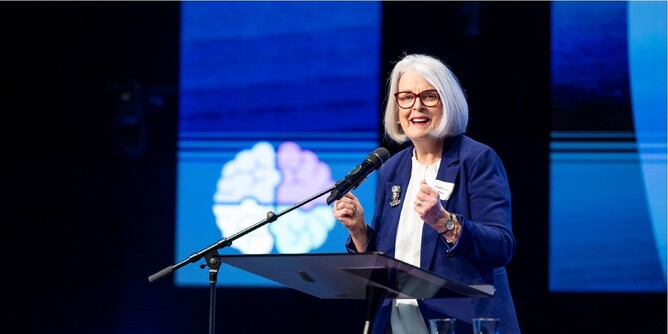"It's time to bring out the 'best china' New Zealand!"
Following the two events held in August, Learning MATTERS Consultant, Ruth Blair, pulled together insights from the Cultivating the Literacy Landscape Symposia, where our trio of keynote speakers delved into the intricacies of teaching reading and revealed a wealth of knowledge and strategies for fostering strong reading skills.
Here are Ruth's insights into their keynotes.
Emily Hanford | Why Are We Here?
Emily Hanford, a senior correspondent and producer for American Public Media, began the symposium by emphasising the complexity of reading instruction. She debunked the misconception that intelligence determines reading proficiency, stressing the importance of effective teaching methods for all students.
Her investigation into the challenges faced by students with dyslexia revealed common comments to parents like "all kids learn differently" or "he will catch up." Unfortunately, these statements often proved untrue in the majority of cases.
Emily introduced her podcast, "Hard Words," focusing on the crucial role of phonics instruction in reading. She underscored the significance of phonics instruction, a topic often debated, stating, "When people are fighting about reading, they are usually fighting about phonics." Emily eloquently demonstrated how phonics is a crucial foundation for reading, as it aligns with the very essence of language – sound. “The other reason I focused on phonics instruction is because one of the things that scientists figured out is that phonics skills are critical when one becomes a good reader. Why is that? Because the starting point for reading is sound.”
While phonics is vital, it's not enough. She discussed the Ladder of Reading and Writing, the Simple View of Reading, and Scarborough’s Rope emphasising that comprehension involves multiple factors. Early reading instruction aligned with the science of reading follows a code emphasis approach to help kids reach meaning. “Whole language and Balanced Literacy are meaning emphasis approaches to reading instruction, as opposed to what’s known as a code emphasis approach which emphasises decoding skills at the beginning of reading instruction.” Early reading instruction, which aligns with the science of reading, is a code emphasis approach that prioritises a focus on both phonics and decoding skills to ensure that children can reach the meaning. “Everyone agrees that meaning is the goal. The question is, how does a little kid get there?”
Emily explained how skilled readers rely less on contextual cues and more on sight recognition. But sight recognition doesn’t mean memorising words; it means that the word has been orthographically mapped to your memory. “What the science shows us is that having kids memorise lots of words is not the best path to build word recognition skills. It turns out that weak word recognition skills are the most common and most debilitating source of reading problems.” Orthographic mapping is crucial; linking sounds, letters, and meaning for proficient reading. Words get orthographically mapped when a child links sounds to written letters. Then they can use their brain power to understand meaning rather than using it on decoding. “Skilled word reading is like a reflex. It is not a detective's game. It is not contextual guessing. It is not a series of strategic actions. It is automatic.” Emily emphasised that good phonics instruction in the early grades is crucial for educational equity.
When it comes to reading, the rich get richer in many different ways - The Matthew Effect shows how proficient readers accumulate advantages.
Emily highlighted connections between quality reading instruction, family income, poverty, and educational outcomes. She explained that in the United States, more children struggle with reading than poverty, highlighting an equity and civil rights issue, as some families can address the problem with financial resources.
"The bottom line from all of this scientific research on reading is that what kids with dyslexia need to learn to become good readers is not substantially different from what all kids need to learn to be good readers."
Professor Pamela Snow | What the Research Tells Us
Professor Pamela Snow's session underscored the paramount importance of teaching reading and its profound impact on students' access to the curriculum. She emphasised, "Teaching reading instruction is the key to evidence-based school improvement because that’s how students access the curriculum." Her words resonated with educators, advocating for the prioritisation of reading instruction.
Prof. Snow explored the connection between reading success and overall well-being, stating, "Reading success is related to behavioural and emotional well-being." She highlighted the role of reading in holistic development, reinforcing the need for robust reading instruction.
Prof. Snow then addressed Balanced Literacy stating, “We need to talk!”. During this conversation, Prof. Snow addressed various facets of reading instruction.
Reading is not innate; it's a skill that can be acquired with proper instruction.
English has a complex writing system, and decoding is crucial for reading comprehension.
Strong oral language skills are necessary but not enough for reading.
Aim to teach 95% of children to read effectively (not 60-70%). “Why would we wait to fail? No child should ever have to recover from their initial reading instruction.”
Early intervention is vital, as literacy challenges become harder to address later.
Putting adjectives with the word ‘Literacy’ is not an acceptable substitute for actual reading instruction and teaching children to read.
Balanced Literacy lacks solid research support for achieving high proficiency.
Teachers need deep knowledge of the English writing system.
A key highlight here would be Professor Snow discussing that when individuals enter a school, they naturally expect to encounter the most knowledgeable experts in the realms of reading and writing. However, she draws an analogy to emphasise how the situation has evolved over time. She likens the high-quality china that once graced teachers’ cabinets to a precious heirloom that has gradually been replaced with inferior plastic substitutes over several decades. It is now imperative for educators to reclaim this invaluable treasure. As teachers gain a deep understanding of the inner workings of the English writing system, they will come to realise its incompatibility with the 3-cueing system when it comes to teaching children.
Professor Snow encourages teachers to regard this knowledge as their cherished family heirloom, one that should be brought back home and cherished like the ‘best china’, to be used every day.Parents shouldn't be responsible for teaching reading; it's the role of schools.
Reading instruction should align with neuroscience.
In her thought-provoking dialogue, Prof. Snow called for educators' accountability, emphasising, "We need teachers to have special bodies of knowledge that other people don’t have, and we need to hold them to high account in applying that knowledge to their work." Her words underscored the responsibility of educators to continually seek expertise and employ evidence-based practices in their teaching.
Leaving Balanced Literacy requires a shift in approach. She emphasised the Simple View of Reading and the importance of both word recognition and language comprehension.
“It’s not our business whether children love reading. Our business is making them proficient readers and they can choose how they use reading across their lifespan.” Skill comes before enjoyment. By Year 3, children should acquire most of their new vocabulary through their own reading. All children need to learn to decode and most need to be taught explicitly. High-quality phonics is necessary, but we must ensure no child is left behind. Effective reading instruction has far-reaching effects on education, employment, mental health, and society.
Associate Professor Lorraine Hammond | How Can We Raise Literacy Rates
Assoc. Prof. Hammond’s session revolved around aligning research with classroom practice. She emphasised that learning to read follows the same path for all children, regardless of their background and discussed ‘HOW’ she teaches children in more affluent urban areas compared to those in the remote areas of the Kimberley. ‘I’ll say from the outset that what I do with them is precisely the same. And that’s hard for some people because people assume these kids are a bit different, might need something different, might need to spend more time outside learning ... no. We’ve all got the same brain. We all learn to read in the same way.”
Assoc. Prof. Hammond introduced the concept of the "Simple View of Teaching" stressing that a combination of passion and knowledge fosters effective educators. She emphasised the need for adaptation, cautioning against holding onto ineffective practices.
Emphasising evidence-based instruction, Assoc. Prof. Hammond highlighted the importance of teachers' understanding of the neurology of reading. "If you are teaching reading and you don’t understand the neurology of it, it’s very hard to step away from Balanced Literacy and some of the things that are still going on."
Children all learn to read the same way, but the teaching methods may differ. Some children succeed despite varied approaches. The notion of providing a buffet of methods for teaching reading isn't necessary.
Assoc. Prof. Hammond’s insights resonated with the need for efficient teaching strategies, urging educators to utilise time on task effectively. "Time on task matters.” She describes that where students focus on learning we need to condense instruction, aiming for long-term memory retention. Reading and spelling are integrated, and we should maintain a fast pace while ensuring comprehension.
She stressed the importance of teaching more in less time, boosting active learning. The teacher's role is vital, requiring stability and fidelity to the task. The instructional approach matters.
The human brain operates the same way globally. Explicit instruction involves breaking down content into smaller parts, keeping students engaged and responsive, checking understanding, and maintaining a suitable pace. Explicit instruction is unscripted, while direct instruction follows a script.
Daily reviews, 20 minutes each morning, reduce cognitive load and enhance long-term memory. We prioritise using valuable teaching methods early for all students, focusing on maximising time on task. Short, effective daily reviews yield significant results.
In her closing remarks, Assoc. Prof. Hammond echoed Maya Angelou's wisdom, "Do the best you can until you know better. Then when you know better, you do better."











